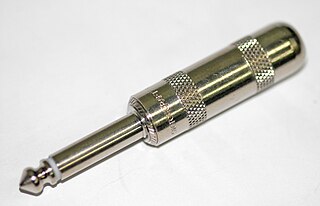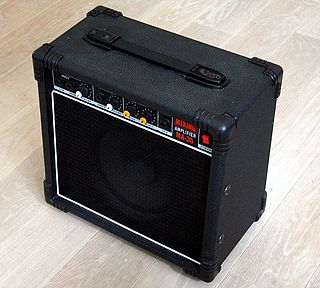
The Atari Lynx is a 16-bit handheld game console that was released by Atari Corporation in September 1989 in North America, and in Europe and Japan in 1990. It was the world's first handheld electronic game with a color LCD. It was also notable for its advanced graphics and ambidextrous layout. The Lynx competed with the Game Boy, as well as the Game Gear and TurboExpress, both released the following year. It was discontinued in 1996.

A sound card is an internal expansion card that provides input and output of audio signals to and from a computer under control of computer programs. The term sound card is also applied to external audio interfaces used for professional audio applications.
Dolby Digital is the name for audio compression technologies developed by Dolby Laboratories. Originally named Dolby Stereo Digital until 1994, except for Dolby TrueHD, the audio compression is lossy. The first use of Dolby Digital was to provide digital sound in cinemas from 35mm film prints; today, it is now also used for other applications such as TV broadcast, radio broadcast via satellite, digital video streaming, DVDs, Blu-ray discs and game consoles.

In sound recording and reproduction, and sound reinforcement systems, a mixing console is an electronic device for combining sounds of many different audio signals. Inputs to the console include microphones being used by singers and for picking up acoustic instruments, signals from electric or electronic instruments, or recorded music. Depending on the type, a mixer is able to control analog or digital signals. The modified signals are summed to produce the combined output signals, which can then be broadcast, amplified through a sound reinforcement system or recorded.

A phone connector, also known as phone jack, audio jack, headphone jack or jack plug, is a family of electrical connectors typically used for analog audio signals.

Reason is a digital audio workstation for creating and editing music and audio developed by Swedish software company Reason Studios. Reason emulates a rack of hardware synthesizers, samplers, signal processors, sequencers, and mixers, all of which can be freely interconnected in an arbitrary manner. Reason can be used either as a complete virtual music studio or as a set of virtual instruments to be used with other sequencing software in a fashion that mimics live performance.

Monaural or monophonic sound reproduction is sound intended to be heard as if it were emanating from one position. This contrasts with stereophonic sound or stereo, which uses two separate audio channels to reproduce sound from two microphones on the right and left side, which is reproduced with two separate loudspeakers to give a sense of the direction of sound sources. In mono, only one loudspeaker is necessary, but, when played through multiple loudspeakers or headphones, identical signals are fed to each speaker, resulting in the perception of one-channel sound "imaging" in one sonic space between the speakers. Monaural recordings, like stereo ones, typically use multiple microphones fed into multiple channels on a recording console, but each channel is "panned" to the center. In the final stage, the various center-panned signal paths are usually mixed down to two identical tracks, which, because they are identical, are perceived upon playback as representing a single unified signal at a single place in the soundstage. In some cases, multitrack sources are mixed to a one-track tape, thus becoming one signal. In the mastering stage, particularly in the days of mono records, the one- or two-track mono master tape was then transferred to a one-track lathe intended to be used in the pressing of a monophonic record. Today, however, monaural recordings are usually mastered to be played on stereo and multi-track formats, yet retain their center-panned mono soundstage characteristics.

Virtual Studio Technology (VST) is an audio plug-in software interface that integrates software synthesizer and effects in digital audio workstations. VST and similar technologies use digital signal processing to simulate traditional recording studio hardware in software. Thousands of plugins exist, both commercial and freeware, and many audio applications support VST under license from its creator, Steinberg.

Pro Tools is a digital audio workstation developed and released by Avid Technology for Microsoft Windows and macOS which can be used for a wide range of sound recording and sound production purposes. Pro Tools can run as standalone software, or operate using a range of external analog/digital converters and internal PCI Local Bus (PCI) or PCIe audio cards with on-board digital signal processors (DSP) to provide effects such as reverb, equalization and compression. Like all digital audio workstation software, Pro Tools can perform the functions of a multitrack tape recorder and audio mixer, along with additional features that can only be performed in the digital domain, such as non-destructive editing, using the Undo feature.
Dolby Pro Logic is a surround sound processing technology developed by Dolby Laboratories, designed to decode soundtracks encoded with Dolby Surround. Dolby Stereo was developed by Dolby in 1976 for analog cinema sound systems. The format was adapted for home use in 1982 as Dolby Surround when HiFi capable consumer VCRs were introduced. It was replaced by the improved Pro-Logic system in 1987.
Scholz Research & Development, Inc. or SR&D is the name of the company founded by musician and engineer Tom Scholz to design and manufacture music technology products. Scholz was an MIT-trained engineer who developed many of his skills working on audio-production equipment as a product design engineer at Polaroid in the early 1970s. A musician in his off-time, he developed a recording studio in the basement of the apartment building where he lived, utilizing many home-built devices. Recordings made in his home studio later became the debut album of the band Boston, while the Scholz's proceeds from the success of his band were used to found the company to further develop and sell market versions of his inventions. Many of the devices were marketed under the Rockman brand.

Logic Pro is a digital audio workstation (DAW) and MIDI sequencer software application for the macOS platform. It was originally created in the early 1990s as Notator Logic, or Logic, by German software developer C-Lab, later Emagic. It became an Apple product, eventually known as Logic Pro, after Apple bought Emagic in 2002. It is the 2nd most popular DAW - after only Ableton Live - according to a survey conducted in 2015.

Delay is an audio effect and an effects unit which records an input signal to an audio storage medium, and then plays it back after a period of time. The delayed signal may either be played back multiple times, or played back into the recording again, to create the sound of a repeating, decaying echo.

The Haeco-CSG or Holzer Audio Engineering-Compatible Stereo Generator system was an analog electronic device developed by Howard Holzer, Chief Engineer at A&M Records in Hollywood, California.
Sonar was a digital audio workstation created by Cakewalk.
TC Electronic is a Danish audio equipment company that designs and imports guitar effects, bass amplification, computer audio interfaces, audio plug-in software, live sound equalisers, studio and post production equipment, studio effect processors, and broadcast loudness processors and meters.

In sound recording and reproduction, audio mixing is the process of combining multitrack recordings into a final mono, stereo or surround sound product. In the process of combining the separate tracks, their relative levels are adjusted and balanced and various processes such as equalization and compression are commonly applied to individual tracks, groups of tracks, and the overall mix. In stereo and surround sound mixing, the placement of the tracks within the stereo field are adjusted and balanced. Audio mixing techniques and approaches vary widely and have a significant influence on the final product.

A keyboard amplifier is a powered electronic amplifier and loudspeaker in a wooden speaker cabinet used for amplification of electronic keyboard instruments. Keyboard amplifiers are distinct from other types of amplification systems such as guitar amplifiers due to the particular challenges associated with making keyboards sound louder on stage; namely, to provide solid low-frequency sound reproduction for the deep basslines which keyboards can play and crisp high-frequency sound for the high-register notes. Another difference between keyboard amplifiers and guitar/bass amplifiers is that keyboard amps are usually designed with a relatively flat frequency response and low distortion. In contrast, many guitar and bass amp designers purposely make their amplifiers modify the frequency response, typically to "roll off" very high frequencies, and most rock and blues guitar amps, and since the 1980s and 1990s, even many bass amps are designed to add distortion or overdrive to the instrument tone.












